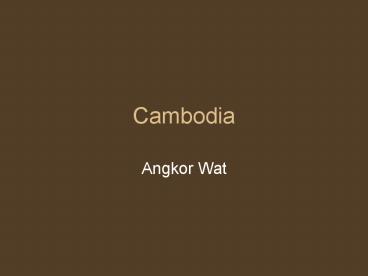Cambodia - PowerPoint PPT Presentation
Title:
Cambodia
Description:
Cambodia. Angkor Wat. Cambodia. Angkor: old kingdom (7th-13th centuries) Capital city: Phnom Penn ... 3.29 Angkor Wat, early 12th century. Angkor Wat. King ... – PowerPoint PPT presentation
Number of Views:80
Avg rating:3.0/5.0
Title: Cambodia
1
Cambodia
- Angkor Wat
2
(No Transcript)
3
Cambodia
- Angkor old kingdom (7th-13th centuries)
- Capital city Phnom Penn
- Religion Hinduism (7th-12th centuries), Mahayana
Buddhism (12th-14th centuries) Theravada
Buddhism (15th-present) - Khmer ethnic
- Mon-Khmer language
4
Hinduism
- Polytheistic religion (worship many gods and
goddesses) - Goal is to achieve moksa--by praying, worshipping
(darsana) and giving offering to gods - Each god has a female companion and rides on
vehicle such as bull (Nandi), lion, goose each
holds some attributes (Siva tridents and Vishnu
conch shell and wheel)
5
Triad
- Brahma-God of Creator
- Vishnu-God of Preserver (has many incarnations
such as Rama and Krishna) - Shiva-God of Destroyer (also the protector of
animals) - Devi-goddess (e.g., Laksmi (Good Fortune) and
Parvati) symbolizing beauty, benevolent, and
wealth as well as power and wrath
6
3.29 Angkor Wat, early 12th century
7
Angkor Wat
- King Suryavarman II (c. 1112-1150 CE)
- Hindu temple, facing West (direction of death),
associates with Vishnu - It symbolizes the center of the universe, Mount
Meru - The moat symbolizes the oceans surrounding the
earth - The succession of concentric galleries represent
the mountain ranges that surround Mount Meru - The towers (Gopura) represent the mountains
peaks - It was converted to Theravada temple in the 15th
century
8
King Suryarvarman II, c. 1112-1150
9
Plan
- Square shape with cruciform cloister
- Enter on the West side through the causeway
- Made of sandstone foundation was made of
laterite - Upper level carries five towers and surrounding
galleries - The summit is enclosed by continuous gallery (60m
square) the center shrine tower is 42m high.
10
(No Transcript)
11
(No Transcript)
12
(No Transcript)
13
Library
14
(No Transcript)
15
Gallery and main towers
16
(No Transcript)
17
(No Transcript)
18
(No Transcript)
19
(No Transcript)
20
Apsaras (celestrial beings)
21
(No Transcript)
22
Apsaras
23
(No Transcript)
24
(No Transcript)
25
Lotus motif
26
(No Transcript)
27
Upper towers
28
Main tower
29
(No Transcript)
30
Vishnu
31
Interior
- sculpture 8 arm Vishnu may have been located in
the main sanctuary - Interior decorated with bas-relief
- Themes Ramayana and Mahabartha epics
- Historic procession of King Suryavarman II and
court - The West and East sides depicted the Heavens and
Hells - Apsaras (celestial beings) approximately 2000
32
(No Transcript)
33
(No Transcript)
34
Suryavarman II
35
Vishnu and Garuda
36
The Judgement of Yama, God of Dead and the
Underworld
37
Battle scene
38
The Churning of the Sea of Milk
- Story taken from the Bhagavata-Purana
- Gods and demons (asuras)
- Naga Vasuki used as a robe for the churning
- Produce the amrita, the elixir of immortality
39
Gods
40
The Churning of the Sea of Milk, E gallery
41
Demons
42
Syam khuk































